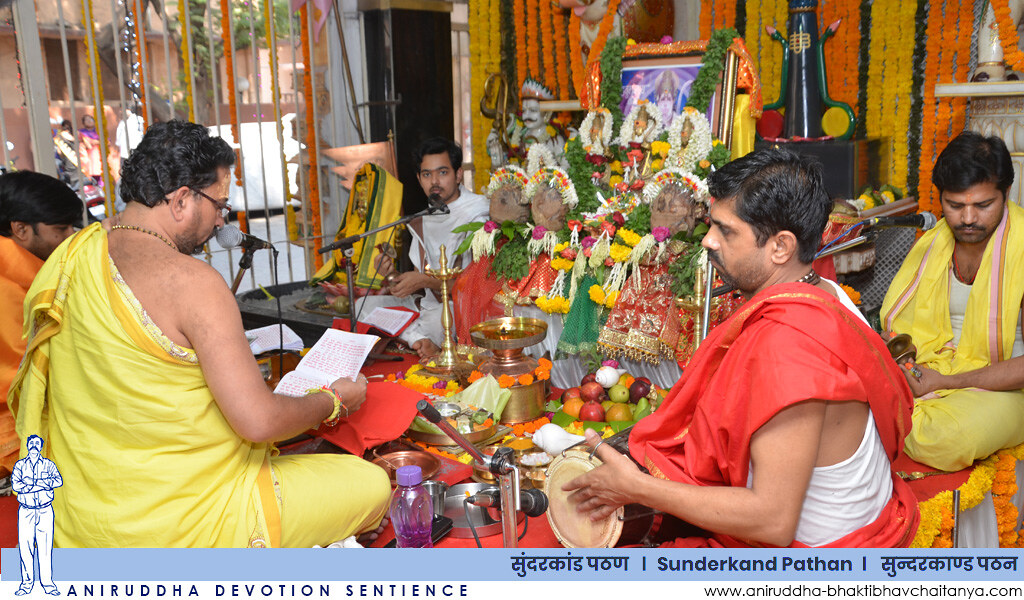Overview
Introduction to Sunderkand
Sunderkand is a significant chapter of the Hindu epic Ramayana. It is a sacred text that narrates the journey of Lord Hanuman to find and connect with Mother Sita, who has been kidnapped by the demon king Ravana. The word ‘Sunderkand’ translates to ‘beautiful chapter’, and it is considered to be one of the most powerful and revered sections of the Ramayana. This chapter is filled with devotion, courage, and determination, as Hanuman overcomes numerous obstacles in his quest to locate Sita. The Introduction to Sunderkand sets the stage for the epic tale that unfolds, capturing the essence of the divine connection between Lord Hanuman and Mother Sita.
Significance of Sunderkand
The Sunderkand is a significant chapter in the Hindu epic Ramayana. It is a sacred text that holds great importance in Hindu mythology and is recited by devotees worldwide. The word ‘Sunderkand’ literally translates to ‘beautiful chapter’ in Hindi. This chapter narrates the journey of Lord Hanuman to Lanka in search of Sita, the wife of Lord Rama. It is believed that reciting or listening to the Sunderkand brings blessings, protection, and spiritual upliftment. In the state of Odisha, there is a popular Odia Sunderkand book available that provides a detailed account of the Sunderkand in the Odia language. This book serves as a valuable resource for those who wish to delve deeper into the significance and teachings of the Sunderkand.
Summary of the Journey
The Sunderkand is a chapter from the epic Ramayana, which narrates the journey of Lord Rama and his companions to find his wife, Sita, who has been kidnapped by the demon king Ravana. The chapter is named after Hanuman, the monkey god, who plays a crucial role in the search for Sita. In the Sunderkand, Hanuman undertakes a perilous journey to the island of Lanka, where Sita is held captive. He faces numerous challenges and overcomes them with his extraordinary strength and devotion to Lord Rama. The chapter highlights the power of faith, courage, and determination in the face of adversity. It serves as a reminder of the importance of connecting with the divine and seeking spiritual guidance in our own journeys of life.
Historical Background
Origin of Sunderkand
The origin of Sunderkand can be traced back to the epic Hindu scripture called Ramayana. Sunderkand is a chapter in the Ramayana that focuses on the adventures of Hanuman, the monkey god. It is believed to have been composed by the sage Valmiki. The word ‘Sunderkand’ translates to ‘beautiful chapter’ in English. This chapter holds great significance for devotees of Lord Rama as it highlights the devotion, courage, and loyalty of Hanuman. Sunderkand is often recited or chanted by devotees to seek blessings and protection from Lord Rama. It serves as a reminder of the power of faith and the importance of staying connected with the divine.
Historical Context
The historical context of the Sunderkand is crucial in understanding its significance. It is a chapter in the ancient Indian epic, the Ramayana, which narrates the journey of Lord Rama and his companions. The Sunderkand specifically focuses on the adventures of Hanuman, the monkey god, as he sets out to find Sita, Lord Rama’s wife, who has been abducted by the demon king Ravana. This chapter is set in the kingdom of Lanka, where Ravana resides. The historical context provides insights into the cultural and religious beliefs of ancient India, as well as the values of devotion, courage, and loyalty that are portrayed in the epic. It offers a glimpse into the challenges faced by the characters and the lessons they learn along the way.
Influence on Culture and Society
The Sunderkand is a book in Odia that holds great significance in the culture and society of the region. It is a sacred text that has been passed down through generations, connecting people with their spiritual roots. The book narrates the heroic journey of Lord Hanuman as he searches for Sita, the wife of Lord Rama. Sunderkand is not just a religious scripture, but also a source of inspiration and guidance for devotees. It has influenced various aspects of culture and society, including literature, music, dance, and art. Many artists and performers have taken inspiration from the Sunderkand to create beautiful works of art that depict the epic tale. The book has also played a role in promoting the Odia language and preserving its rich heritage. Overall, the Sunderkand has left a lasting impact on the culture and society of the region, shaping the beliefs and traditions of the people.
The Story of Hanuman

Introduction to Hanuman
Hanuman is a prominent figure in Hindu mythology and is revered by millions of people around the world. He is known for his unwavering devotion to Lord Rama and his extraordinary strength and bravery. Hanuman is often depicted as a monkey-faced deity, symbolizing his playful and mischievous nature. In Hinduism, Hanuman is considered the epitome of loyalty, courage, and selflessness. His story is an inspiration to all those who seek to connect with the divine and lead a life of righteousness. Through his adventures and exploits, Hanuman teaches us the importance of faith, devotion, and the power of good over evil.
Hanuman’s Role in Sunderkand
Hanuman’s role in Sunderkand is crucial and significant. As the central character of the epic, Hanuman plays a pivotal role in the journey through Sunderkand. He is portrayed as a devoted and loyal servant of Lord Rama, who embarks on a mission to find Rama’s wife, Sita, who has been kidnapped by the demon king, Ravana. Hanuman’s unwavering faith, immense strength, and extraordinary abilities make him an integral part of the story. His determination and courage inspire readers to overcome obstacles and stay committed to their goals. Hanuman’s selflessness and dedication to the divine cause make him a revered figure in Hindu mythology. The story of Hanuman in Sunderkand serves as a reminder of the power of faith, devotion, and the triumph of good over evil.
Lessons from Hanuman’s Journey
Hanuman’s journey in the Sunderkand holds many valuable lessons for us. One of the key lessons is the importance of unwavering devotion. Throughout his journey, Hanuman demonstrates his unwavering devotion to Lord Rama. He overcomes numerous obstacles and challenges with his unwavering faith and dedication. Another lesson we can learn from Hanuman’s journey is the power of selflessness. Hanuman puts aside his own desires and ego to serve Lord Rama and help him in his mission. His selfless acts of courage and sacrifice inspire us to prioritize the needs of others over our own. Additionally, Hanuman’s journey teaches us the significance of perseverance. Despite facing countless difficulties, Hanuman never gives up and continues his search for Sita. His determination and perseverance remind us to stay committed to our goals and never lose hope, even in the face of adversity. Overall, Hanuman’s journey in the Sunderkand serves as a powerful reminder of the importance of devotion, selflessness, and perseverance in our own lives.
Spiritual Significance
Connecting with the Divine
In the spiritual journey of connecting with the Divine, one finds solace and enlightenment through various means. Sundara Kanda, an important chapter in the epic Ramayana, serves as a profound guide in this quest for spiritual connection. It narrates the heroic journey of Lord Hanuman to find and deliver a message to Sita, the wife of Lord Rama, who was held captive by the demon king Ravana. Sundara Kanda showcases the unwavering devotion, strength, and determination of Lord Hanuman, making it a source of inspiration for seekers of divine connection. The chapter highlights the importance of faith, courage, and selflessness in the pursuit of connecting with the sacred. Through the enchanting verses of Sundara Kanda, one can embark on a transformative journey towards discovering the true essence of spirituality.
Symbolism in Sunderkand
Sunderkand is a significant chapter in the epic Ramayana, where Hanuman embarks on a journey to find Sita, the wife of Lord Rama, who has been abducted by the demon king Ravana. This chapter is filled with profound symbolism that conveys deep spiritual and philosophical messages. One of the key symbols in Sunderkand is the bridge built by Hanuman to cross the ocean. This bridge represents the connection between the earthly realm and the divine realm, highlighting the importance of bridging the gap between the material and the spiritual. Another symbol in Sunderkand is the ring given by Lord Rama to Hanuman as a token of trust. This ring symbolizes the bond of loyalty and devotion between Lord Rama and Hanuman, emphasizing the significance of trust in relationships. Overall, Sunderkand is a treasure trove of symbolism that invites readers to explore the profound teachings and lessons embedded within this sacred chapter of the Ramayana.
Impact on Spiritual Growth
The Sunderkand is a significant text in Hindu mythology that holds immense spiritual significance. It is a chapter from the Indian epic, Ramayana, which narrates the journey of Lord Hanuman to find and rescue Lord Rama’s wife, Sita. The impact of Sunderkand on spiritual growth is profound. Reading and reciting Sunderkand helps individuals connect with the divine and deepen their understanding of devotion. The story of Hanuman’s unwavering dedication and selflessness inspires devotees to cultivate these qualities in their own lives. The recitation of Sunderkand is believed to bring about inner peace, strength, and protection from negative energies. It is also considered a powerful tool for overcoming obstacles and finding guidance in difficult times. The sacred verses of Sunderkand have the power to purify the mind, awaken spiritual consciousness, and foster a sense of unity with the divine. Overall, the impact of Sunderkand on spiritual growth is transformative, offering solace, inspiration, and a deeper connection with the sacred.
Devotional Practices
Recitation of Sunderkand
The recitation of Sunderkand is a sacred practice in Hinduism that holds great significance. It is a chapter from the epic Ramayana, where Hanuman embarks on a journey to find Sita, the wife of Lord Rama. This recitation is believed to bring immense blessings and divine protection to the devotees. Sunderkand is often recited with utmost devotion and reverence, as it is believed to connect the devotee with the sacred energy of Hanuman. The recitation of Sunderkand is a powerful way to invoke the grace of the divine and seek spiritual guidance in one’s life.
Chanting Hanuman Chalisa
Chanting Hanuman Chalisa is an integral part of the spiritual practice of connecting with the sacred. The Hanuman Chalisa is a devotional hymn dedicated to Lord Hanuman, who is considered the epitome of devotion, courage, and strength. It is believed that chanting the Hanuman Chalisa with utmost devotion can bring immense blessings and protection. The practice of chanting this sacred hymn is often done in the presence of a Tulsi plant, which is considered sacred in Hinduism. Tulsi is believed to be an incarnation of the goddess Lakshmi and is revered for its medicinal properties. Chanting Hanuman Chalisa in the presence of Tulsi is believed to enhance the spiritual experience and deepen the connection with the divine. The fragrance of Tulsi leaves adds a sense of purity and sanctity to the chanting, creating a serene and sacred atmosphere. Through the chanting of Hanuman Chalisa, devotees seek the blessings of Lord Hanuman and strive to overcome obstacles, fears, and challenges in their spiritual journey.
Observing Hanuman Jayanti
Observing Hanuman Jayanti is a significant event for devotees of Lord Hanuman. It is celebrated with great enthusiasm and devotion across the country. Hanuman Jayanti marks the birth anniversary of Lord Hanuman, who is revered as a symbol of strength, devotion, and loyalty. On this auspicious day, devotees gather in temples and offer prayers to seek his blessings. The celebrations include reciting the Sunderkand, a chapter from the epic Ramayana that narrates the heroic deeds of Lord Hanuman. Sunderkand is known for its powerful verses and profound teachings. It is believed that reciting Sunderkand helps in crossing language barriers and connecting with the sacred. Devotees also engage in various spiritual activities such as fasting, chanting Hanuman Chalisa, and organizing satsangs. Hanuman Jayanti is not only a religious festival but also a time for introspection and self-reflection, inspiring individuals to embody the qualities of Lord Hanuman in their lives.
Modern Relevance
Sunderkand in Contemporary Literature
Sunderkand is a significant part of contemporary literature, as it explores the theme of connecting with the sacred. Through the journey depicted in Sunderkand, readers are taken on a spiritual quest, experiencing the divine presence and gaining a deeper understanding of themselves and the world around them. This sacred text has been widely celebrated for its profound insights and teachings, making it a popular choice among readers seeking spiritual enlightenment. The powerful verses and vivid descriptions in Sunderkand create a captivating narrative that resonates with readers of all backgrounds. By delving into the depths of Sunderkand, one can embark on a transformative journey of self-discovery and connect with the sacred in a profound and meaningful way.
Sunderkand in Popular Culture
Sunderkand in Popular Culture
Sunderkand, a chapter from the Indian epic Ramayana, has had a significant impact on popular culture. It has been widely celebrated and revered for its profound spiritual teachings and its portrayal of the journey of Lord Hanuman. The story of Sunderkand has been adapted into various forms of art, including literature, music, and theater. Many people have found solace and inspiration in the journey depicted in Sunderkand, which serves as a reminder of the power of devotion and the triumph of good over evil. The popularity of Sunderkand in popular culture is a testament to its timeless message and its ability to resonate with people from all walks of life.
Author Profile

Latest entries
- 28 June 2025BlogHow to Choose the Best High-Yield Savings Account with 5%+ Interest in India (2025 Guide)
- 28 December 2024BlogTop 6 Employee Management Software for Small Businesses
- 19 December 2024BlogShri Hanuman Chalisa in Hindi Text with English Translation
- 7 August 2024BlogTop 13 Online Master of Social Work Programs

